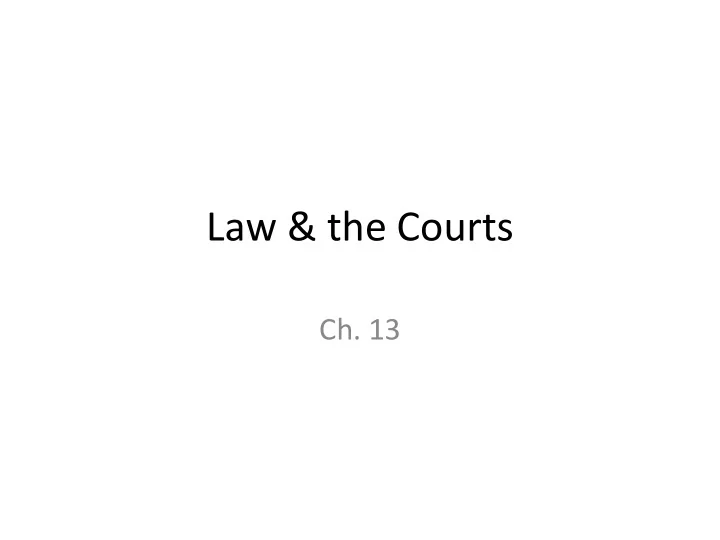

Law & the Courts Ch. 13
The Nature of Law • At a very basic level, “the law” has to distinguish & categorize the many ways people can harm each other – Examples
• Important distinctions: 1. Civil vs. criminal law 2. State vs. federal crimes 3. Felonies vs. misdemeanors
Civil Law • Torts (wrongs) done by one person to another – Liability , not guilt – Trials award damages , rarely punishment – Lower standard of proof than criminal cases • “Preponderance of the evidence” – Examples: defamation, fraud, wrongful death
Criminal Law • Torts deemed so serious that they harm the whole society – Trials find defendants “guilty” or “not guilty” – Punishment can include jail time, death – High standard of proof – “Beyond a reasonable doubt”
• In the US, there is not one legal system – there are at least 51 – State & federal laws – States have jurisdiction over much of what happens purely inside their borders – The federal gov’t generally has jurisdiction over interstate matters
Felonies & Misdemeanors • Crimes fall into 1 of 2 general categories, depending on their seriousness. – Misdemeanors: crimes punishable by 1 year of jail or less • Ex: assault, DUI, theft, voter fraud, illegal use of stink bombs – Felonies: crimes punishable by > 1 year in prison • Ex: murder, kidnapping, bribery, DUI with bodily injury
• The criminal law must: 1. Compartmentalize bad behavior AND 2. Draw specific distinctions between similar actions • Like killing someone – What’s murder? • First degree? Second degree? Huh? – Manslaughter?
• The “details” of a criminal case get sorted out at a trial – A trial is about 2 things: 1. Law 2. Facts (evidence) – Judge’s role is mostly that of a referee
• So, consider a killing: – Murder requires the intent to kill, or for the killing to occur during another felony (ex: robbery) – First degree murder requires premeditation ; the intent to kill formulated beforehand – Killing without intent generally falls into the manslaughter family of crimes
• In a criminal trial, lawyers for both sides try to convince the jury to agree with them – The judge mostly functions as a referee • Makes sure procedure is followed – Fair process = fair outcome • Evidence, testimony, rules, etc. – Example: automobile searches – The jury decides what the facts are
Structure of Court System US Supreme Court US Courts of Appeals State supreme courts State appeals courts US District Courts State trial courts
• Note the 2 major divisions: 1. State and federal courts 2. Trial and appellate courts • Appeal : a request to a higher court to address mistakes made at trial
• 2006: – 101,000,000 appeals requested – 168,000 granted • 2 granted for every 1000 requested • Why so few?
• Remember: fair process = fair outcome – Even if it’s wrong! • Appeals are generally granted if and only if the trial judge made legal or procedural errors – Violated Constitutional rights – Applied wrong law
• 2 things that don’t get you an appeal: 1. Jury “mistake” 2. New evidence (usually) • There’s a strong tendency to preserve jury verdicts, even if they’re shown to be wrong later
• One thing this system DOES do is, over time, fills lots and lots of “holes” in the legal system – What’s an “unreasonable” search? – What’s “effective counsel”?
• Over many years and many cases, some issues get taken off the table, while new ones emerge • Internet crime – Especially pornography & child pornography – “Sexting”??? • Terrorism • Juvenile justice
3 Eras of Supreme Court Decisions • 1 st Era (1798 – 1860) – Key issue: limits on national government power – Key cases: • Marbury v. Madison • McCulloch v. Maryland
• 2 nd Era (1865-1930s) – Key issue: government authority over economy – Key case: US v. Carolene Products • Commerce clause • “Rational basis” test
• 3 rd Era (1950s – present?) – Key issue: government authority over personal conduct • Privacy, contraception, abortion, flag burning, surveillance, discrimination, obscenity, …
Recommend
More recommend